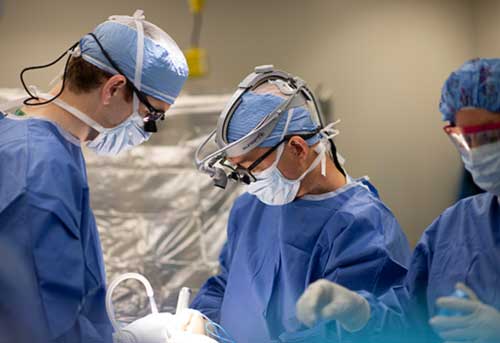The Most Recent Advancements by the Best Spine Surgeons in St Louis MO
Wiki Article
An Overview of Back Conditions That Often Outcome in Surgical Treatments
Spine problems such as herniated discs, spine constriction, and degenerative disc disease regularly demand surgical treatments when conservative treatments stop working to relieve relentless signs and symptoms. Comprehending the nuances of each problem and the equivalent surgical choices, such as discectomy or spine combination, is crucial for efficient management.Herniated Discs
Although lots of people with herniated discs might find relief via conventional treatments, surgical treatment ends up being a required consideration when signs worsen or persist - best spine surgeons in st louis mo. A herniated disc occurs when the soft internal gel of a spine disc sticks out through its outer layer, possibly leading and compressing neighboring nerves to pain, tingling, or weakness in the extremitiesTraditional administration usually consists of physical therapy, pain medications, and corticosteroid shots, which aim to minimize inflammation and improve function. Nevertheless, in instances where these methods fail to ease incapacitating signs and symptoms, medical alternatives might be discovered.
The most common surgical procedure for herniated discs is a discectomy, which entails the removal of the herniated portion of the disc to eliminate stress on the influenced nerve root. In much more extreme cases, spinal combination may be needed to support the influenced vertebrae.
Patients are encouraged to talk about the potential risks and benefits of surgical treatment with their doctor to make an informed choice. Ultimately, the goal of any kind of surgical intervention is to recover feature, alleviate discomfort, and boost overall lifestyle for individuals struggling with herniated discs.
Spinal Stenosis
Spinal constriction takes place when the rooms within the back slim, resulting in increased pressure on the spinal cable and nerves. This condition can create in various regions of the spine, consisting of the lumbar and cervical locations, commonly because of age-related adjustments, such as degenerative disc condition, arthritis, or thickening of tendons.Individuals with spinal stenosis may offer with signs that include pain, feeling numb, tingling, or weakness, primarily in the legs or arms. These symptoms can be intensified by activities that entail standing or walking, usually leading people to seek relief with conventional treatments like physical treatment, drugs, or epidural steroid injections.
Nevertheless, when these non-surgical interventions fail to offer appropriate alleviation, surgical alternatives may be thought about. Usual surgeries for spine constriction include laminectomy, which entails the removal of component of the vertebra to reduce stress, and back blend, which maintains the afflicted area. The decision to go after surgery is normally based upon the extent of signs and symptoms, the level of functional problems, and the overall health of the individual. Trigger diagnosis and management are important to stop further neurological concession and enhance quality of life.
Spondylolisthesis
Spondylolisthesis takes place when one vertebra slides onward over another, leading to imbalance of the spine. This problem can arise from different aspects, including congenital issues, injury, or degenerative changes in the back. It is most commonly observed in the lumbar region, particularly at the L4-L5 and L5-S1 degrees.
Therapy alternatives their explanation differ based upon the intensity of the slippage and the signs and symptoms presented. Conventional procedures, including physical therapy, pain administration, and task alteration, are frequently the initial line of protection. When non-surgical approaches stop working to ease signs and symptoms or when significant nerve compression is existing, medical intervention might be necessitated. Surgical choices can include back blend or decompression procedures, focused on recovering positioning and relieving neurological signs and symptoms. Early medical diagnosis and ideal administration are essential for ideal outcomes in individuals with spondylolisthesis.
Degenerative Disc Condition

Clients with DDD usually experience pain that might radiate to the arms or legs, relying on the affected area of the spinal column. The problem can be my website identified through a mix of professional assessment, imaging research studies, and patient history. Therapy choices normally start with traditional steps, consisting of physical treatment, pain management, and lifestyle alterations. However, when these strategies fail to supply adequate alleviation, surgical interventions may be considered.
Surgical choices for DDD might consist of back fusion or artificial disc substitute, targeted at stabilizing the affected section and alleviating discomfort (best spine surgeons in st louis mo). Eventually, the selection of treatment is embellished, thinking about the severity of the condition, client wellness, and way of living factors
Spinal Lumps

Back tumors can occur from numerous factors, consisting of hereditary tendency, ecological impacts, and pre-existing clinical problems. Clients may provide with a range of signs, consisting of local pain, neurological deficits, weak point, or changes in bowel and bladder feature, depending on the growth's size and place.
Medical diagnosis commonly entails imaging studies such as MRI or CT scans, which help define the lump's characteristics and impact on bordering structures. In examining treatment alternatives, the lump's area, quality, and type are essential factors to consider. Surgical intervention may be called for to ease symptoms, obtain a biopsy, or get rid of the tumor totally. The goal of surgery is often to unwind neural components and stabilize the back. Adjuvant therapies, consisting of radiation or radiation treatment, might additionally be essential depending on the tumor's nature. Early detection and intervention are vital for enhancing end results in clients with spine lumps.
Verdict
In recap, back problems such as herniated discs, spine constriction, spondylolisthesis, degenerative disc condition, and back lumps regularly require surgical treatment as a result of their possible to trigger significant pain and functional problems. While conventional therapies might provide temporary alleviation, surgical options come to be vital when symptoms linger or intensify. Timely medical diagnosis and treatment play a vital function in bring back function and improving the lifestyle for affected people, underscoring the value of extensive spine treatment.
Report this wiki page